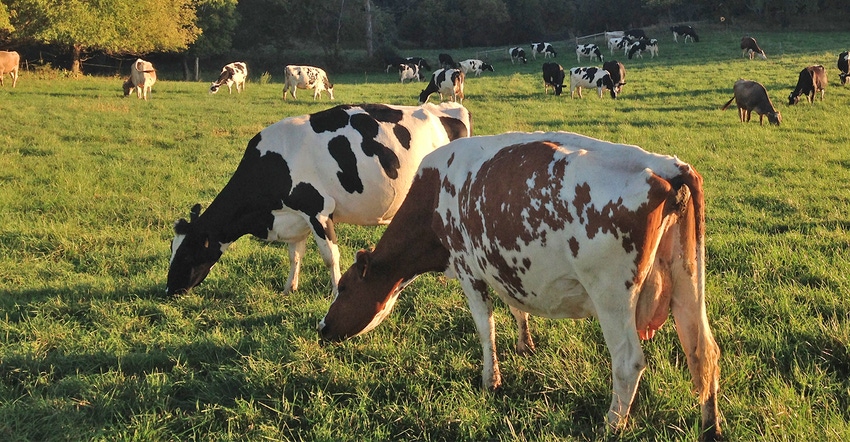
Consistent milking procedures and cow cleanliness are key factors in how dairy farmers obtain high-quality milk from their cows.
For Schefers Brothers LLC, Paynesville, Minn., a team of three milkers handling six milking units in their 66-cow tiestall barn follow the same procedures each time — pre-dipping teats, wiping them dry with two paper towels, completely milking out each quarter and then post-dipping.

COW CREW: Attending to herd management on the Schefers Brothers dairy farm near Paynesville, Minn., are Jason Schefers (left), Ken and Julie Schefers, and Ralph Schefers (on tractor). Photo by Ava Schefers

“With three people milking, we feel that helps us do a good job,” says Ken Schefers. “We know our cows and how they milk. For example, some might have slow-milking quarters. We do not have automatic take-offs. It’s important to milk out each cow clean.”
Ken farms with his wife, Julie, and his brother Ralph, managing an 80-cow registered Holstein dairy herd. Ken and Julie’s son Jason joined the operation three years ago. Full-time employee Jessie Berg rounds out the farm team.
Enough labor, routine test number monitoring
For their year-round efforts at working to provide high-quality milk, the Scheferses were one of 112 dairy farms recently recognized by the Minnesota Department of Agriculture for their herd’s low somatic cell count milk. SCC is one measure of milk quality. A low SCC provides a high-quality raw product that is better for cheese production and makes for longer shelf life for bottled milk.
In honor of June Dairy Month, the top farms are being recognized for achieving an average SCC of under 100,000 cells/ml.
Having enough labor to do daily chores is key to maintaining high milk quality, Ken says. Cows in tiestalls are currently bedded with oat hulls. If a cow is leaking milk, hydrated lime is spread underneath her on the stall floor to disinfect and dry the surface. As family members and staff walk around and feed cows three times a day, they also scrape manure off stall floors and into grated gutters.
Another management practice that helps with keeping SCC low is routine monitoring of test numbers.
“We do DHIA [Dairy Herd Improvement Association] SCC testing, and the first thing we look at are cows with high SCC,” Ken says. “We know, then, who to watch, and if we need to treat them. SCC testing is very helpful.”
The Scheferses and Berg also pay attention to sire selection, since bulls are listed with daughters’ susceptibility to mastitis and SCCs.
Ensuring everyone is trained
Another dairy farm on the MDA’s low-SCC list is Zweber Farms LLC, Elko, Minn., co-owned and operated by Jon and Lisa Zweber; their son, Tim; and Tim’s wife, Emily. The Zwebers milk about 130 cows in a double-12 swing parlor. Their herd, mostly Holsteins with registered Brown Swiss and a few crossbreds, is 100% grass-fed and organic.
Top management practices for obtaining and maintaining low SCC are training, communication, testing and culling, says Tim.
“We make sure everyone on the farm is trained on how to identify and manage high-count cows. We have two to three part-time employees, and we are always stressing cleanliness in the parlor,” Tim says. “We have a shared iCal [online] calendar, where we note high-count cows and any changes we make to milk isolation. We are also looking up our milk quality data on our co-op website and talking about which cows might be the problem cows if counts rise. We regularly test with DHIA and use California Mastitis Tests to identify high-count cows.”
Knowing chronic mastitis cows are not profitable, they cull them, Tim says.
“As an organic herd, there isn’t much we can use in the way of treating mastitis, so prevention is key,” Emily says. “When a cow is identified as high-count, we isolate her milk, make sure she is milked out completely and use Udder Comfort cream to soothe.”
Their milk prep routine is similar to the Scheferses in that it focuses on cleanliness and consistency — for both cows and the parlor.
“We have a saying: If you wouldn't put your mouth on it, it isn’t clean enough,” Emily says.
They keep cows dry, healthy and clean during the grazing season by moving them to fresh pastures every 12 hours. In the winter, the Zwebers’ cows have access to a sand bedding in a freestall barn.
University of Minnesota dairy experts have worked with the state’s dairy farmers since 2003 to lower somatic cell counts with the university’s Quality Count$ program. When the initiative began back then, the 100 herds honored that year included those with SCC averages as high as 144,000, compared to the current goal of obtaining an SCC under 100,000.
See the entire list of Minnesota’s top dairy herds with low somatic cell counts from the Minnesota Department of Agriculture.
About the Author(s)
You May Also Like






